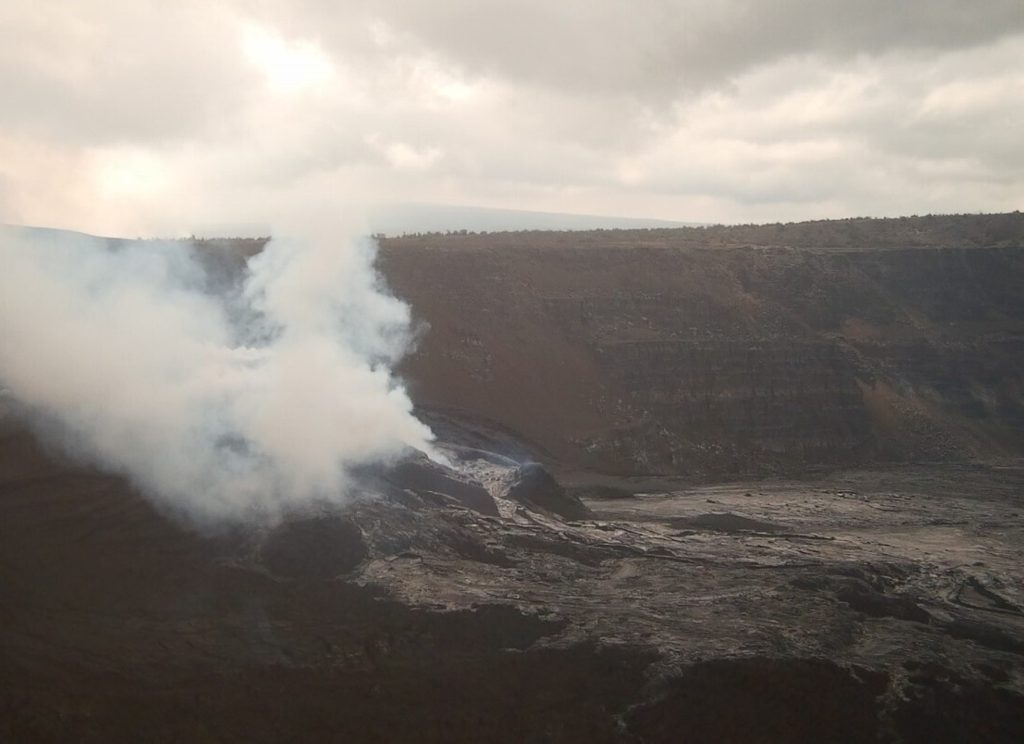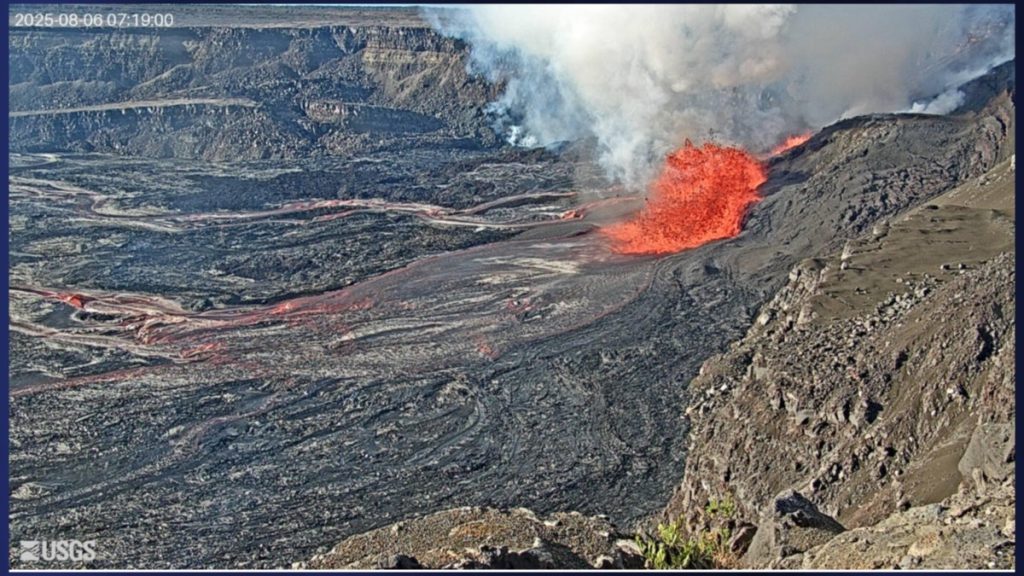UPDATE: Kīlauea’s Episode 30 ends nearly 12 hours after lava fountains, flows begin anew, including from new Halemaʻumaʻu fissure

Update at 11:42 p.m. Aug. 6, 2025: After almost 12 hours of continuous lava fountaining — that included a new fissure vent that transected the south wall of Halemaʻumaʻu Crater and erupted for about 3 hours and 20 minutes early this morning — Episode 30 of the ongoing episodic eruption in southern part of Kaluapele, the summit caldera, at Kīlauea volcano confined within Hawaiʻi Volcanoes National Park on the Big Island ended abruptly at 12:55 p.m. today.
Lava flows continued to drain down the north vent — which was the last to cease fountaining — within Halemaʻumaʻu for about 5 minutes after fountaining ceased.
The south vent stopped erupting at about 12:50 p.m., with lava flows from the new fissure vent stopping by 4:40 a.m.
Lava fountains reached up to 300 feet at their highest during Episode 30, which started at 1:20 a.m. today. Lava flows from this episode on the floor of Halemaʻumaʻu might continue to exhibit slow movement or incandescence as they cool and solidify throughout the next few days.
The Uēkahuna tiltmeter at the volcano’s summit recorded about 22.5 microradians of deflation during this episode.
The end of this episode — as has been typical since the episodic summit eruption began Dec. 23, 2024 — was coincident with a rapid change from deflation to inflation at the summit and decrease in seismic tremor intensity.
Most episodes of lava fountaining since the eruption started have continued for about a day or less and were separated by pauses in eruptive activity of generally at least several days.
Volcanic gas emissions have greatly decreased. No changes have been detected in the East Rift Zone or Southwest Rift Zone.
Kīlauea’s Volcano Alert Level remains at Watch and its Aviation Color Code is still at Orange.
Pele’s hair and tephra could affect areas downwind of eruptive vents.
As sulfur dioxide is continuously released from the summit, it will react in the atmosphere to create the visible haze known as vog, or volcanic smog, downwind of Kīlauea.
Sulfur dioxide and vog can cause respiratory and other problems at high concentrations.
Hawaiian Volcano Observatory continues to closely monitor Kīlauea and will issue a Volcanic Activity Notice at the start of the next eruptive episode.
If possible, the observatory also will issue a status report at the onset of low-level precursory activity.
Regularly scheduled daily updates for Kīlauea are posted at the Hawaiian Volcano Observatory website.
Update at 10:03 a.m., Aug. 6, 2025: Lava flows from the north vent now have covered about 60% of the floor of Halemaʻumaʻu crater during Episode 30 of the ongoing Kīlauea eruption, which began about 1:20 a.m. on Wednesday.
These lava fountains are expected to end later today, according to the Hawaiian Volcano Observatory.
No activity has been noted along Kīlauea’s East Rift Zone or Southwest Rift Zone.
Current hazards include volcanic gas emissions, along with windblown volcanic glass (Pele’s hair) and tephra ( deposited during earlier eruptive episodes.
Original post at 7:54 a.m. Aug. 6, 2025: Episode 30 of the ongoing Kīlauea eruption on the Big Island began at about 1:20 a.m. on Wednesday, producing lava fountains of 150 to 300 feet high from the vent, according to officials with the Hawaiian Volcano Observatory.
Thus far, the lava flows from the north vent have covered 20% of Halemaʻumaʻu crater floor. A new vent can also be seen on the south vent area. Small lines can be seen producing lower volume flows.
The new vent for this eruption seems to be associated with a cluster of small earthquakes just south of Halemaʻumaʻu.
Episode 30 was preceded by spatter fountains and vigorous overflows that began at approximately 12:56 a.m. and continued to increase in intensity until about 1:20 a.m., when sustained, energetic fountaining began.

According to the National Weather Service, winds are light and variable from the north direction, which suggests that volcanic gas emissions and volcanic material may be distributed to the south but may fall in a broader pattern than during typical trade winds.
Currently, all eruptive activity is confined to Halemaʻumaʻu crater within Hawaiʻi Volcanoes National Park. Commercial airports in Hawaiʻi County are not being affected by this eruption.
Individuals interested in watching the foundation can watch three Kīlauea summit livestream videos by clicking, here: V1cam, V2cam, V3cam. Cameras KPcam and MKcam provide views of the plume height for aviation purposes
Additionally on Monday, ABC News reported that the Institute of Volcanology and Seismology of the Far Eastern Branch of the Russian Academy of Sciences (RAS) explained that this was the first time in almost 300 years that seven volcanoes erupted at once in the region.
The 8.8 magnitude earthquake struck off Russia’s Kamchatka Peninsula last week triggered a tsunami watch for the State of Hawaiʻi.
The director of the institute, Alexey Ozerov, described the situation as an “extremely rare phenomenon that can be described as a parade of volcanic eruptions.”
Kīlauea Volcano remains at an Alert Level and the Aviation Color Code remains at Watch/Orange.



